16 COOL THINGS YOU MAY NOT KNOW ABOUT CHARIOTS
It's more than just Ben Hur and a chariot race
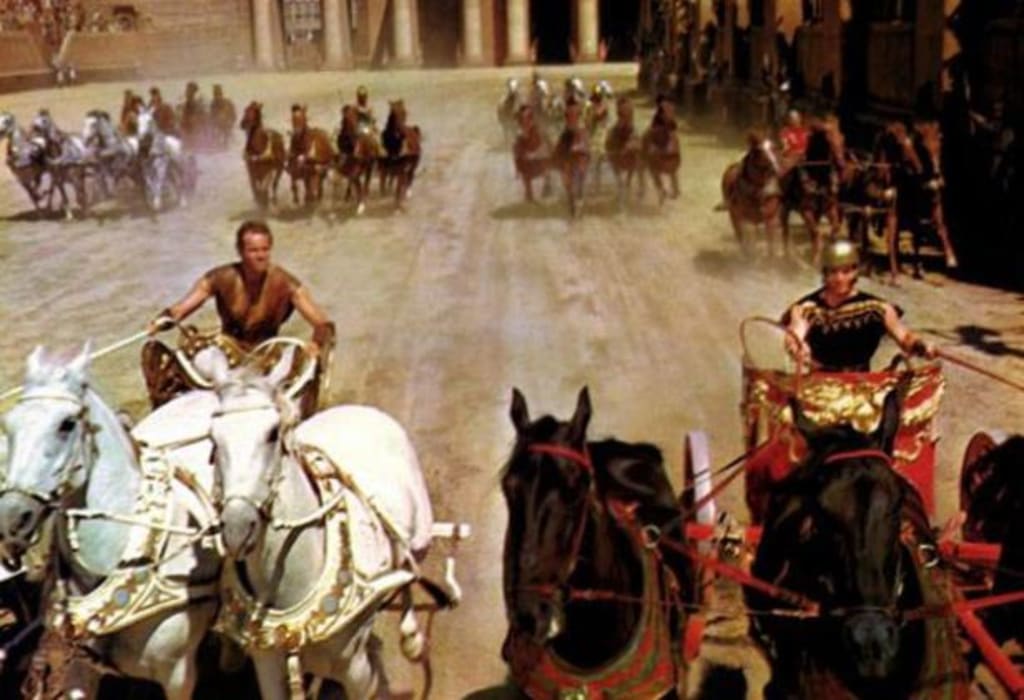
WHAT WERE CHARIOTS USED FOR?
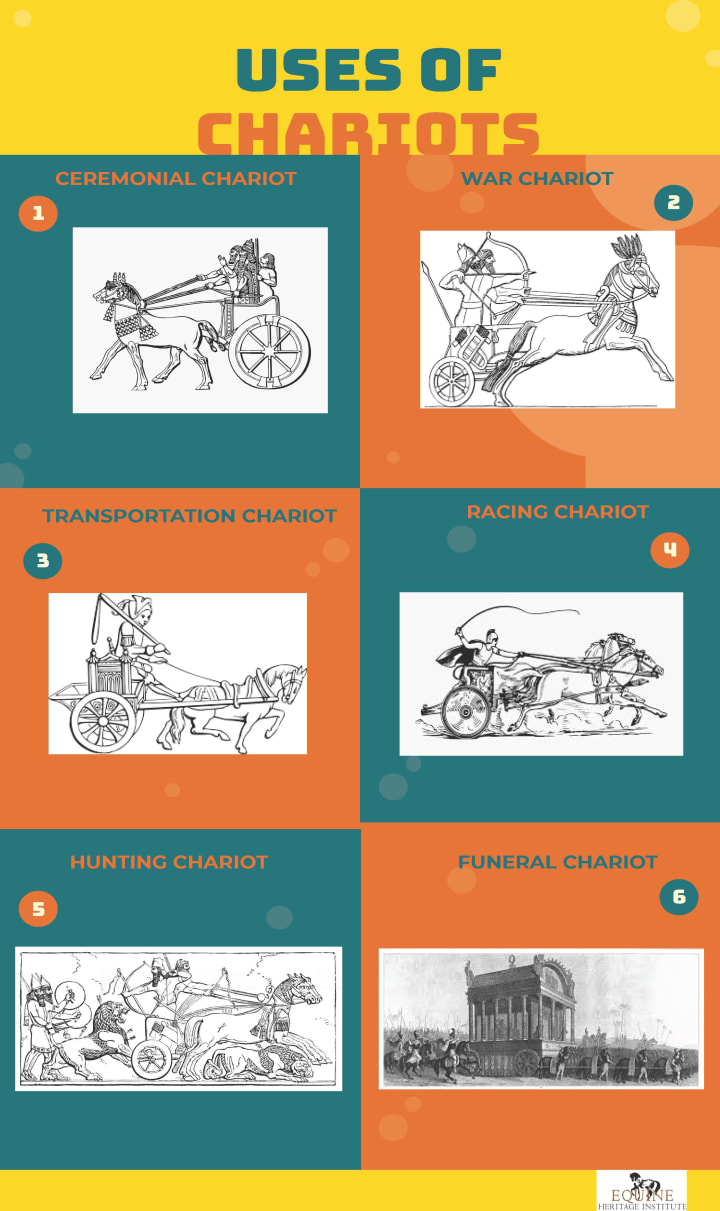
Contrary to popular belief, chariots were not just used for war and races. The chariot is a two-wheeled vehicle put to one or more horses. Chariots were used for ceremonies, funerals, general transportation, hunting and yes..... war and races.
WHO INVENTED THE CHARIOT?
Some scholars argue that the chariot was most likely a product of the ancient Near East early in the 2nd millennium BC. Archaeologist Joost Crouwel writes that “Chariots were not sudden inventions, but developed out of earlier vehicles that were mounted on disk or cross-bar wheels. This development can best be traced in the Near East, where spoke-wheeled and horse-drawn true chariots are first attested in the earlier part of the second millennium BC and were illustrated on a Syrian cylinder seal dated to the 18th or 17th century BC.” The earliest known chariots have been found in Sintashta burials, and the culture is considered a strong candidate for the origin of the technology, which spread throughout the Old World and played an important role in ancient warfare. The first known written information about horses was in 1345 BC. In 1345 BC a Mitannian horse-master known as Kikkuli wrote the “Chariot Training Manual.” It gave a detailed plan for training and caring for horses.
WERE EGYPTIANS THE FIRST TO USE WAR CHARIOTS?

Most people in ancient times were nomads who moved from place to place to find food and water so, it was important to have control of valuable hunting lands and places with water. When the chariot was invented, those who first used the new invention were able to storm their neighbors and seize valuable hunting and pasturing land rights. Around 1720 -1710 BC Egypt began to be invaded by a people who became known as the Hyk-Sos, "shepherd kings". Contrary to popular belief, the Egyptians had no knowledge of chariots until they were introduced by the Hyksos. Egypt was able to achieve its largest empire and greatest power by the addition of the horse and chariot that were first introduced to the Egyptians by the Hyksos. The chariot became the supreme military weapon.
DID THE ISRAELITES HAVE CHARIOTS?
Dueteronomy 17:16 expressly forbids the king of Israel to increase greatly the number of his horses “nor cause the people to return to Egypt to the end that he should multiply his horses”. In the time of David, the Arameans and Canaanites had large numbers of chariots and war horses. But strangely enough, the Israelites still made no use of them. When David fought Hadadezer the King of Zobah he faced a large cavalry and many chariots. 2 Samuel 8:4 says that David took from him [Zobah] a thousand chariots, and seven hundred horsemen, and twenty thousand footmen and David houghed (hamstrung, to render them incapable of use in war) all the chariot horses. Given the size and scope of the empire he inherited from his father David, Solomon no doubt needed means for transportation and trade. I Kings 10:26, 28 says that Solomon had thousands of horses imported from Egypt. In so doing, he violated one of the precepts of God's law, first given to Israel 450 years earlier. He also imported chariots and sold horses and chariots to other nations. Solomon armed the Hittites and Syria, providing them with the means to attack Israel and Judah in later years (I Kings 11:23-25; 20:1; II Chronicles 22:5).
DID THE GREEKS HAVE CHARIOTS?

Mycenae, Athens and Thebes were big and important cites in Greece. The Mycenaeans had something the other cities did not have – they were the first people from Greece to use horses in battle. With their weapons and large chariots pulled by horses, they were able to take over the entire region of the Aegean Sea. They were the first great Greek civilization.
DID THE ENTIRE ANCIENT WORLD USE CHARIOTS?
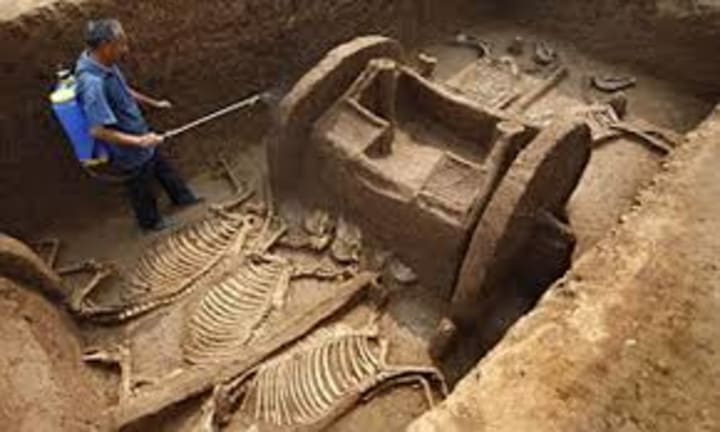
While other parts of the world had already been using chariots for hundreds of years, Europe did not learn of the chariot until much later. In Europe, the chariot was transmitted, perhaps by the Etruscans, to the Celts, who were using it in the British Isles in about the 5th century BC. Eventually though, everywhere in Europe, the Middle East, India and China all used chariots. Kings, great pharaohs and even unimportant rulers used the chariot as their master weapon. Ancient art work created to honor the rulers shows them riding in chariots. During the Western Zhou Dynasty (1100 BC - 771 BC) military strength was measured by the number of war chariots each kingdom had. Horses were so important to the Chinese that horses and the vehicles they pulled were buried with their owners for the afterlife.
WHO HAD THE LARGEST CHARIOTS IN ANCIENT TIMES?
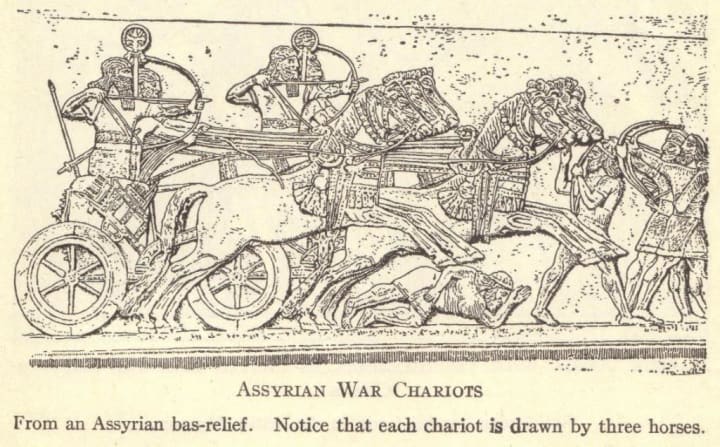
The Assyrians became an aggressive people under the rule of King Ashurnasirpal II who reigned from 884 to 859 BC. He invaded the lands of his neighbors up and down the Tigris and Euphrates Rivers. The Assyrians were the first to organize their army into units with commanders. They built large powerful chariots that could be pulled by multiple horses. They also built roads large enough for their large chariots to move their armies and equipment quickly to where they were needed.
WHEN DID CHARIOT RACING START?
Chariot Racing was a sport in the Ancient Olympics. The Ancient Olympic Games took place every four years in Olympia in Greece from 776 BC to at least 393 AD. The four-horse chariot race was the most popular, prestigious and long-lasting event in the Ancient Olympics.
WHERE WERE CHARIOT RACES HELD IN ANCIENT ROME?
The Colosseum in Rome was a place with amazing events such as fights between gladiators There were dangerous animals such as lions, tigers, bears, elephants, leopards, hippopotamuses and bulls that condemned criminals had to fight. The Romans would often re-enact famous military victories too; they would fill the Colosseum with water and reenact naval battles! But chariot races were not held there; chariot races were held at the Circus Maximus. It was originally built in the sixth century BC. It was also used to host the Roman Games (Ludi Romani) which honored the god Jupiter. These games were held every September with 15 days of chariot races and military processions.
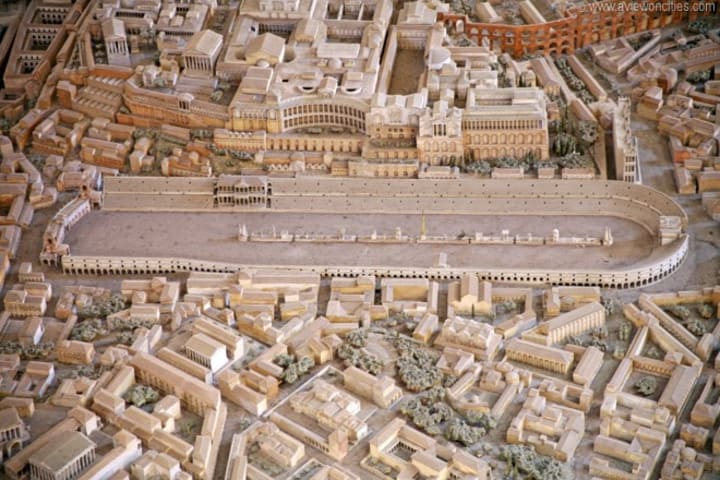
The Circus Maximus had:
• room for two hundred fifty thousand spectators!
• a track covered in sand about the length of five football fields.
• twelve starting gates for chariots at the open end of the track.
• a decorated barrier called a spina complete with obelisks running down the center of the track.
• tapering turning posts placed at each end of the track.
• lap markers in the shape of eggs and dolphins which were turned to mark the completion of each of the seven circuits of a typical race.
HOW MANY HORSES PULLED A CHARIOT ?

The chariots were pulled by teams of four, six, eight or twelve horses. The lead horse in a chariot race was often as famous or more famous than the driver. Fans knew the breeding line and all the details of their favorite horses. Teams of four horses were called a quadriga, meaning four yoked. The two outside horses were called the funalis and the two middle ones were the iguales, or the actual yoke horses. The funalis were the faster horses who would set the pace, while the iguales were the ones who pulled the weight of chariot and kept it steady. All the horses would need to work as a team and match pace with each other and take signals from their driver on when to slow down and when to speed up. A bad horse would have spelled disaster for the whole team. The inside funalis horse was the one closest to the spina; he had the most difficult job because he had to lead the team around the sharp turns while keeping the fast pace. When a specific horse was named in a quadriga in ancient records, it would usually be the inside funalis horse. Some of the names of hero race horses were: Abigieus, Lucidus, Cotynus, Galata, Pompeianus. The names mean nothing to us now, of course, but the mere mention in the stadium of “Abigieus” would drive the people crazy. Horses needed to be very strong and fast and agile too. They needed enough speed to gallop the straightaways and still be able to negotiate the dangerous turns at the turning posts; that is where most chariots would overturn. The chariot, driver and horses had to complete seven full laps around the Circus Maximus for a total of about four miles.
DID THE CHARIOT RACERS WIN MONEY?
Instead of the victory going to the driver and horses, all the glory went to the winning owner of the horses and chariot. This made the chariot races very important for wealthy and powerful people. Women could not race but they could own horses. Even though the glory went to the owner, a skilled charioteer did become highly sought after and very famous - like our top athletes today. The most famous charioteer was Scorpus; he won two thousand races! Although there were individual stars, there were four main teams named after the colors they wore – the Reds, Whites, Blues and Greens. People had much loyalty to their teams; much like football today. Spectators were encouraged to sabotage the opposing team by throwing lead amulets, studded with nails, at the racers. As you can imagine, clashes between supporters of opposing teams happened often.
WERE THE HORSES THAT RACED FAMOUS TOO?

Horses became famous too. Just like the Kentucky Derby today, horses for the chariot races were specially bred. Race horses were bred and trained on private and later, imperial farms. When ancient Roman records mentioned horse breeds the Numidian breed was mentioned most frequently. Other breeds used were the Spanish horses. The training of a race horse would begin about the age of five and their careers could last up to twenty years. After their racing careers, if they were successful, they were used for breeding.
In later years of the Roman Empire, the Roman emperor Caligula owned a retired, unbeaten chariot horse named Incitatus. Incitatus had a stable made of marble and a stall made of ivory. He wore only purple blankets, the color of royalty, and had jewels hanging from around his neck. The horse had its own servants and its oats were mixed with gold flakes. The emperor would issue invitations, on the horse’s behalf, inviting dignitaries to dinners attended by the horse’s servants and would host lavish birthday parties in the horse’s honor.
WHAT DID CHARIOT RACERS WEAR?

Roman wall painting depicting a chariot race. From Pompeii: Casa delle Quadrighe (House of the four-horse chariots, or House of the Chariot Race). Location: VII 2, 25, Pompeii. Now in the Naples Museum Dated by the museum: ca. 68-79 AD.
The charioteers from each of the factions wore a short, decorated tunic in the color of their team and leather strips around the chest, arms, and legs. Charioteers wore little body protection and only a light helmet; their practice of wrapping the reins tightly around their waists, so they could use their body weight to control the horses, was exceedingly dangerous in the case of accidents, since they could be dragged and trampled before they could cut themselves loose with the dagger that they always carried.
WHAT WERE CHARIOTS MADE OF?
The Egyptian horse drawn chariot typically consisted of a light wooden semicircular framework with an open back surmounting an axle and two wheels of four or six spokes. It had a metal covering for the axes, which reduced friction. Some other wooden parts were strengthened by covering them with metal sleeves. Egyptian chariots were lighter and faster than those of other major powers in the Middle East.
Roman chariots used for racing were built differently. A study of a 2,000-year-old toy chariot found in the Tiber River in the early 1890s and now on display at the British Museum, has revealed a secret trick. To increase the winning chances an iron rim was mounted on the right wheel only of the two-wheeled chariot. "The basic wheels were always of wood, animal hide glue, and rawhide strips (at critical joints) that tighten upon drying, like clamps," explained author Bela Sandor, professor emeritus of engineering physics at the University of Wisconsin at Madison. Any iron tire for racing would be a very thin strip of iron on the outside of the wooden rim, best when heat-shrunk on the wood, to consolidate the whole wheel. Adding the strip of iron to the right wheel improved a charioteer's chances of winning a race to roughly 80 percent, according to a study published in the latest issue of the Journal of Roman Archaeology. Unfortunately, no actual Roman racing chariots have survived. The archaeological evidence for the single-tire configuration only comes from the small toy model now on display at the British Museum.
When British archaeologist Howard Carter entered King Tut's treasure-packed tomb in 1922, he discovered two large ceremonial chariots and a smaller, highly decorated one. These chariots were likely not designed for warfare but rather, carried King Tutankhamun and Queen Ankhesenamun during ceremonies and parades. The gold-covered vehicle is believed to have been pulled by two horses. (below top) The three other chariots found were lighter and made for daily use. (below middle) The fact that the vehicles were dismantled helped their preservation. The wheel rim would have bent under the chariot's weight and been permanently deformed if the chariots weren't disassembled.



This scene is from the side of a chest, made of wood covered in a layer of plaster, which is painted with incredibly detailed scenes of Tutankhamun - either hunting wild animals or in battle. c.1300BC
WHEN DID ARMIES STOP USING CHARIOTS FOR WARFARE?
The chariot was doomed by the same thing that allowed it to excel – horse breeding. Stronger horses could carry men on their backs into battle. Cavalry were more maneuverable than chariots, more flexible and a more efficient use of manpower. Instead of two horses pulling one driver and one archer, two horses could carry two archers or two men running the enemy down with swords and lances. Yet chariots continued to be used particularly for hunting and sometimes for sport racing long after the demise of its usefulness in war.
WHEN AND WHY DID CHARIOT RACES END?
Like Rome, there were many wonderful buildings in Constantinople (an ancient city in modern-day Turkey that's now known as Istanbul). The Hippodrome was the sporting and social center of Constantinople. The Hippodrome was used for chariot races, important festivals and commemorative events. The most important event was the anniversary of the founding of the city by Constantine I. The city’s population gathered to celebrate the birth of the city. The festival was held every eleventh of May, starting in 323 AD and continuing for a thousand years! In the time of Justinian, chariot racing was the sport that had diehard fans. The two most popular teams were the Greens and the Blues. The Blues’ fans were most often members of the upper class and the Greens’ were most often members of the lower class. The fans were fanatical and sometimes even violent! Fans in the Hippodrome would cheer on their favorite charioteers and chariot teams with the cry, "Nika!", which means “Conquer!", "Win!" and "Victory!”
In 532 AD there was a lot of unhappiness over taxes that people had to pay; the buildings and the expansion of the empire cost money and the money had to come from someplace. The citizens thought that they were not the ones who should foot the bill so there was a riot. The ringleaders of the riot were supposed to be executed but two of them were able to escape. One was a fan of the Blues, the other a fan of the Greens. They were hidden away safely in a monastery. Their supporters decided to ask the emperor for mercy for these two men at the next chariot race. On January 13, 532 AD, when the chariot races were scheduled to begin, members of both the Blues and the Greens loudly pleaded with the emperor to show mercy to the two men. Imagine that – the Blues and the Greens agreeing on something! When they did not get an answer, both factions began to cry out, "Nika! Nika!" The Hippodrome erupted in violence, and soon the mob took to the streets. For several days, the Blues and Greens rioted throughout Constantinople burning buildings and even trying to crown a new ruler. Emperor Justinian nearly fled the capital but his wife, Theodora, convinced him that it was nobler to stay and fight for his crown. Encouraged by her words, Justinian had his guards block the exits to the Hippodrome which the rioters were using as their headquarters. Then the guards ambushed the Hippodrome with mercenary troops.
By the time the battle ended, the riot was crushed and an estimated thirty thousand people were dead - as much as ten percent of Constantinople’s entire population! It took years for the city and its people to recover. The Hippodrome was shut down, and races were suspended for five years. No one was willing to move against Justinian after this. He was able to go forward with all his ambitious plans. He rebuilt the city, conquered territory in Italy and completed his law codes. But chariot racing did not recover from what would become known as the Nika Riots. This was the end of chariot racing as a mass spectator sport within Byzantium
SOURCES FOR FURTHER READING
https://www.ancient.eu/chariot/
https://www.beliefnet.com/faiths/christianity/who-were-the-hyksos-and-why-were-they-important-to-the-bible.aspx
http://www.vroma.org/~bmcmanus/charioteer.html
http://www.touregypt.net/featurestories/chariots.htm
https://www.seeker.com/secret-of-roman-race-chariots-found-2187581176.html
http://www.griffith.ox.ac.uk/gri/4tutchar.html
http://www.nbcnews.com/id/38545625/ns/technology_and_science-science/t/king-tuts-chariots-were-formula-one-cars/
https://www.seeker.com/king-tuts-chariots-ferraris-of-ancient-egypt-1766183355.html
http://www.asahi.com/ajw/articles/AJ201910300011.html
https://www.warhistoryonline.com/ancient-history/rise-fall-chariot.html
https://www.smithsonianmag.com/history/blue-versus-green-rocking-the-byzantine-empire-113325928/
http://www.womeninthebible.net/war-in-the-bible/horses-chariot/
https://www.heraldofhope.org.au/horses-chariots/
https://aratta.wordpress.com/2015/07/01/the-wheel-and-the-chariot/
https://www.arce.org/resource/hyksos
https://loneyeti.wordpress.com/2019/05/18/the-late-bronze-age-chariot-after-the-discussion-on-the-finds-at-sanauli/
https://www.brown.edu/Departments/Joukowsky_Institute/courses/fightingpharaohs10/9985.html
About the Creator
Mary Chris Foxworthy
Mary Chris combines her life-long love affair with horses with a passion for keeping history alive. She is an active competitor at horse shows and is known for her work as a research writer for the Equine Heritage Institute.


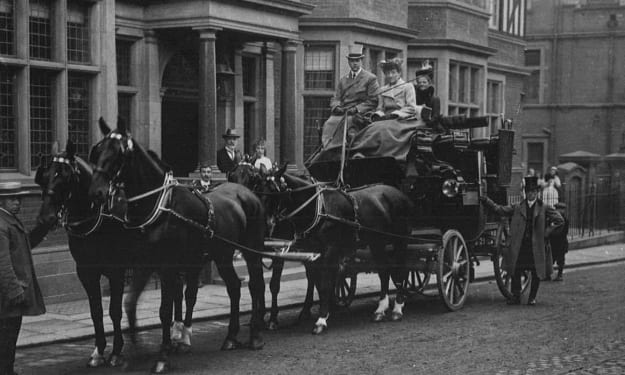



Comments
There are no comments for this story
Be the first to respond and start the conversation.